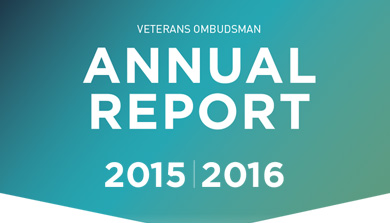Table of Contents
- A Message from the Ombudsman
- How We Help
- A Message from the Veterans Ombudsman Advisory Council
- A Word from our Deputy Ombudsman & Executive Director
- Timeline – Brief Highlights & Notable Events
- Helping Veterans
- The Year at a Glance
- What Lies Ahead
- Financial Statements
- Footnotes
A Message from the Ombudsman
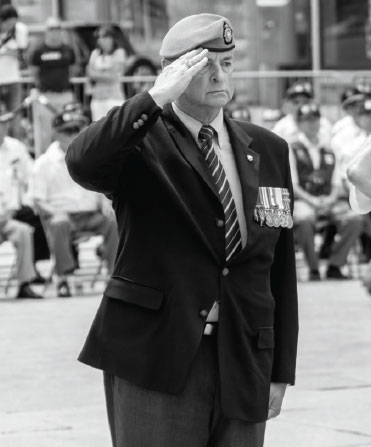
This has been an important year for Veterans and their families, with several announcements on improvements to benefits and services for Veterans. I see this forward motion in support of our Veterans as a welcome step in the right direction.
There is, of course, more work for the government to do in implementing these changes, and yet more work remains to address shortcomings in the support provided to Veterans and their families.
Looking back on the past year, I am pleased with the role my team and I played in informing and fuelling a much-needed dialogue among influencers and stakeholders within the Veterans’ community. The recommendations that emerged from this dialogue reflected and complemented the priorities we had set out for the Office to achieve fairness for Veterans. In my view, these discussions contributed to the positive measures that were announced in Budget 2016, such as expanding access and benefits to better support ill and injured Veterans and their families. Most of all, I was pleased to see that many of the recommendations made by my Office in the past have been addressed in the Minister of Veterans Affairs Canada’s mandate letter and the recent federal Budget. I am hopeful that the government’s commitment to a Veteran-centric approach will help further improve the services provided to our Veterans.
Service-delivery approaches need to evolve. Putting in place a simplified and efficient Veteran-centric service-delivery approach will require continued collaboration to ensure that even the most complex cases get the right level of support and that all Veterans get treated fairly.
“If I had a magic wand, I would list all the outcomes we need to achieve support for Veterans and their families. Some of the outcomes I would consider include:
- Financial security for life;
- Best possible health care;
- Fair compensation for pain and suffering;
- A successful transition to a new job or to the best possible quality of life if unable to work;
- A simplified Veteran-centric service delivery with timely decisions.”
During this past year, I have had many opportunities to brief Parliamentarians both individually and through Committees. At these briefings, I was able to inform key decision-makers about important Veterans’ issues requiring their attention. I believe these meetings were an essential input to the work being done by Parliamentarians on improved service-delivery at Veterans Affairs Canada as well as crucial changes to improve the lives of Canada’s Veterans as reflected in Budget 2016.
What we achieved this past year speaks volumes. None of this would have been possible without the support and counsel of my office, my advisors and our stakeholders. I wish to thank the members of my Advisory Council for their support throughout the year – their invaluable insights continue to inform the very important debates that help shape our priorities and recommendations. I’d like to extend my deep appreciation to countless Veterans’ advocates and members of Veterans’ groups and organizations for their efforts in keeping us focused on the issues of greatest importance to Veterans. I want to offer my heartfelt thanks to those who volunteer countless hours of their time to look out for Veterans. Last but not least, I want to thank the members of my team who contributed to making this Office so effective in supporting Veterans in their quest for assistance and fairness.
Guy Parent
Veterans Ombudsman
How We Help
Who We Are
The Veterans Ombudsman (VO) is an impartial and independent officer within the Government of Canada who advocates for Veterans’ rights. He and his Office work to ensure that Canada's Veterans, serving members of the Canadian Armed Forces CAF and the RCMP, and other clients of Veterans Affairs Canada (VAC), are treated respectfully, in accordance with the Veterans Bill of RightsFootnote 1, and receive the services and benefits that they require in a fair, timely, and efficient manner.
As the only federally-mandated voice of Veterans, the Ombudsman plays an important role in raising awareness of the needs and concerns of the entire Veterans’ community.
“It is time that benefits and service delivery are simplified and meet Veterans’ needs. Veterans and their families deserve no less.”
Who We Serve
The Office of the Veterans Ombudsman (OVO) assists members of the Veterans’ community, as well as other clients of Veterans Affairs Canada (VAC):
- Veterans of the Second World War and the Korean War
- Veterans of the Canadian Armed Forces (CAF) - (Regular Force and Reserve Force)
- Serving members of the CAF (Regular Force and Reserve Force)
- Veterans of the RCMP
- Serving members of the RCMP
- Immediate family members and caregivers of any of the above-mentioned groups; and
- Survivors of Veterans.
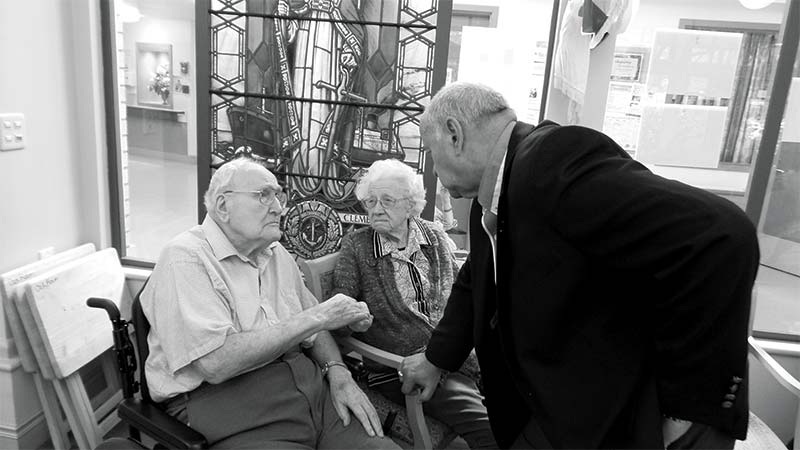
What We Do
The Ombudsman and his Office:
- address complaints from individuals who believe they have been treated unfairly by VAC or other service providers;
- assist those who call for help, often as a last resort, by facilitating referrals to service providers who can best help them;
- provide information about Veterans’ rights, benefits and services provided by VAC and other service providers;
- conduct research to produce reviews and reports containing recommendations to address systemic issues that can potentially affect many other Veterans and clients of VAC; and
- provide advice to the Minister of Veterans Affairs on issues of importance to Veterans.
“Let’s go beyond today’s ideas and shape tomorrow by clearly defining Veterans’ outcomes – the end results that we want to achieve – and figure out the steps needed to obtain those results for Veterans and their families.”
How We Carry Out Our MandateFootnote 2
Our work is carried out through:
- evidence-based analysis and reporting;
- a foundation of fairnessFootnote 3 that can be objectively measured in terms of the adequacy, sufficiency and accessibility of benefits and services; and
- best practices outlined by the International Ombudsman Association and the Forum of Canadian Ombudsman.
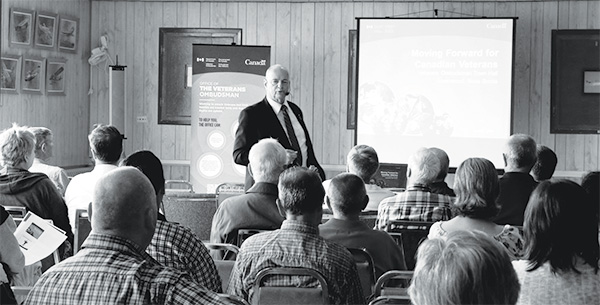
A Message from the Veterans Ombudsman Advisory Council
The Veterans Ombudsman Advisory Council (VOAC) is made up of a group of ten members who provide advice to the Veterans Ombudsman on issues related to his mandate. As Veterans’ representatives, council members assist in promoting the well-being of all Veterans by identifying emerging issues of importance to the Veterans’ community and by providing advice to the Ombudsman on how to best approach those issues. In addition, council members help raise awareness of the Office and liaise with Veterans’ organizations so that they too can have a voice at the Advisory Council.
The Council meets face-to-face twice annually, but engages on an ongoing basis on issues that arise. They provide the Ombudsman with advice on topical Veterans’ issues and make suggestions on how to improve support to Canada’s Veterans and their families. At each meeting, VOAC members are brought up-to-date on the previous six months’ activities by the Veterans Ombudsman and his team and are presented with the work plan for the coming six months. Besides advising the Veterans Ombudsman, VOAC also acts as a sounding board on issues, strategies and priorities. As was the case in the past year, VOAC is usually impressed and complimentary on the activities and work of the OVO. However, VOAC has shown little hesitation in making suggestions on different approaches or methods to improve the results of the work underway or being planned, when appropriate.
VOAC members come from many different backgrounds. While most, but not all, have served in the CAF or the RCMP, their military and non-military experience varies considerably.
We have two Royal Canadian Air Force pilots: Colonel (Retired) Pierre Allard who went on to serve as Service Bureau Director at the Royal Canadian Legion’s Dominion Command, and Dr. James Popplow who served as aeromedical standards and clinical services flight surgeon in 1 Canadian Air Division Headquarters, Winnipeg.
Luc O'Bomsawin is an eight-year Veteran of the CAF and President and Director of the Quebec chapter of the National Aboriginal Veterans Association and the Quebec representative for the Assembly of First Nations of Quebec and Labrador. The Reverend James H. Brown, whom I met in Afghanistan in 2008 when he was serving with 2PPCLI Battle Group, served in all three services and, in 2005, was selected by the Chief of Defence Staff to be the Chaplain for the Aboriginal Spiritual Journey to the cemeteries and battlefields of WW1 and WW2.
Royal Canadian Navy Commander (Retired) Heather J. Armstrong is a personnel specialist who is past President of the Naval Officers' Association of Canada (Ottawa branch). Our RCMP representative, Calvin Small, is Past President of the RCMP Veterans Association. Jim Lowther, a 15-year Veteran of the CAF, is the co-founder of VETS Canada.
“The OVO is known for excellence in ombudsmanry and is considered the voice of Veterans.”
Also, we have two civilian specialist members: Stacey de Savoye, the wife of a serving (CAF) member, a mother of three, and a social worker with extensive experience working with CAF families, and Dr. Heidi Sveistrup from the University of Ottawa’s Faculty of Health Services who is a specialist in rehabilitation sciences.
At the June 2016 meeting, VOAC members expressed their collective satisfaction with what the Veterans Ombudsman and his team have achieved in the past year in relation to both the national level of Veterans’ issues, as well as the resolution of individual Veterans’ concerns. At the national level, in large measure, the work of the Ombudsman has been focused on improving the New Veterans Charter (NVC). After several years of widely recognized quality evidence-based work by the OVO, step-by-incremental-step, legislated improvements have been made with more progress anticipated in the future. Of equal importance is that many hundreds of individual Veterans’ concerns are being routinely resolved every day by the Ombudsman and his team working cooperatively with Veterans and VAC.
VOAC members are pleased that we can contribute to the continuing success of our Veterans Ombudsman’s efforts to serve Canada’s Veterans and their families well. In our view, this past year was a solid success!
J.E.L. Gollner
VOAC Member
A Word from our Deputy Ombudsman & Executive Director
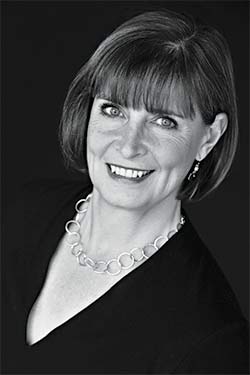
What an interesting and productive year this has been; l too feel that 2015-2016 has been a turning point for Veterans and their families. I congratulate all those who work tirelessly to ensure fairness for Canada’s Veterans. To give the reader an idea of all that we have been able to achieve this past year, I am including a detailed timeline highlighting the most notable events of the year for the OVO.
Numbers Speak for Themselves
We are proud of our accomplishments and even prouder still to back them up with numbers. Our two-page “Year at a Glance” gives the reader a sense of what the OVO was able to achieve in 2015-2016 by working closely with Veterans, their families, and stakeholders.
In addition to this quick snapshot of accomplishments, which includes the four reviews and reports that were issued this year, the Office made progress on a number of fronts.
This year, the Office raised its profile in the research community, completing phase one of a qualitative research study that aims to identify the determinants of a successful transition by interviewing Veterans who have, themselves, successfully transitioned. A literature review of the current research in this area as well as our research methodology was presented at the Canadian Institute for Military and Veteran Health Research Conference in November 2015.
Working closely with the Office of the DND/CF Ombudsman, we mapped the medical release process of Regular and Reserve Forces and identified the challenges faced by both groups during transition to civilian life. Together, the two offices collaborated on the development of three educational pieces and a video on the phases of transition. They also produced a review and infographic material on the supports and services available to military families in transition. As a follow-up to this work, the OVO has launched a dialogue on caregiver compensation.
When it comes to the way we operate, we believe strongly in continuous improvement as a means of achieving greater efficiencies and effectiveness so that we are serving Veterans as best we can. This year, we:
- revised the Terms of Reference of the VO Advisory Council and appointed four new members to fill vacancies;
- revised the VO Commendation process to introduce new commendation categories;
- reviewed frontline operations, including existing tools and processes, to improve service delivery to Veterans;
- contributed to the Joint CAF/VAC Team 20/20 initiative and Communications Task Forces;
- leveraged social media to engage nationally.
This is just a sample of our accomplishments in delivering on our mandate. Our organization is served by a dedicated group of people who work simultaneously on many fronts to improve the lives of Canada’s Veterans. I would like to take this opportunity to congratulate and thank the individuals who work at OVO. They continue to give their best to the job each and every day. Thanks to their efforts, our organization remains strong, relevant and ready to meet the challenges of the years to come!
Sharon Squire
Deputy Ombudsman & Executive Director
Timeline – Brief Highlights & Notable Events
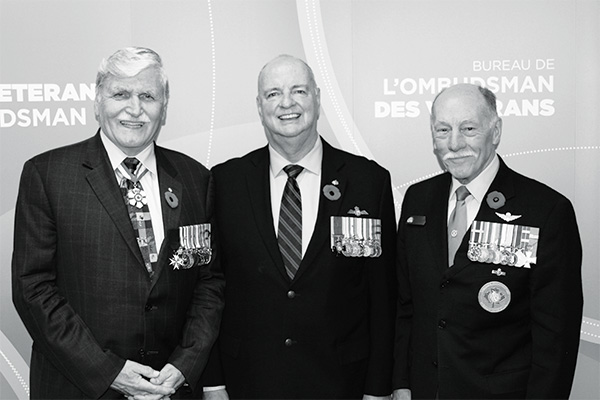
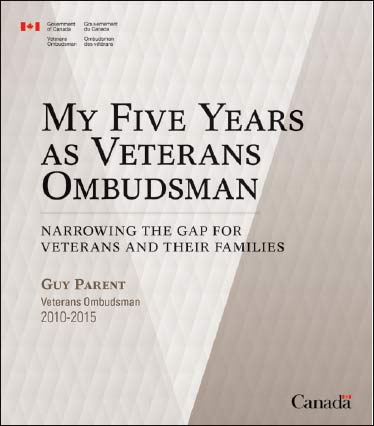
APRIL 2015 – The VO appeared in front of the House of Commons Standing Committee on Veterans Affairs (ACVA) to discuss transition services; he also addressed the 56th Quebec Provincial Command Convention as the Royal Canadian Legion (RCL) celebrated its 90th Anniversary.
MAY 2015 – The VO travelled to the Netherlands for the Commemoration Ceremonies of the 70th Anniversary of their Liberation; the Office published a status update on OVO priorities & ACVA recommendations; the VO appeared in front of both ACVA & the Senate Sub-Committee on Veterans Affairs (VEAC) to discuss changes proposed to the NVC as part of Bill C-59, the proposed Budget 2015 implementation bill.
JUNE 2015 – The OVO held an all-staff and a VOAC meeting; the VO and staff representatives conducted Outreach in Greenwood, NS as well as in Comox and Victoria, BC. Public Town Halls were held in each location. Military and family support facilities, as well as VAC Offices were visited, in addition to some Veterans’ organizations.
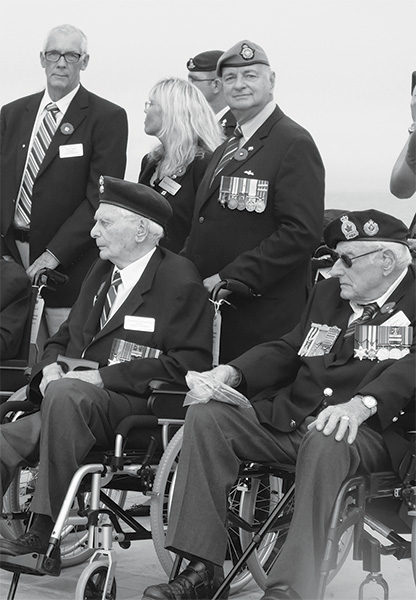
JULY 2015 – The VO published My Five Years as Veterans Ombudsman to report on what his team has done to help resolve issues of concern to Canada’s Veterans and their families, the challenges they faced and what is left to do.
SEPTEMBER 2015 – The VO was a guest speaker and one of three Forum of Canadian Ombudsman panel members at the Osgoode Hall Law School during the Essentials for Ombuds course.
NOVEMBER 2015 – The OVO held its Bi-annual VOAC Meeting in Ottawa, in conjunction with the 2015 VO Commendation Ceremony. Award recipients were LGen the Hon. (Ret’d) Romeo Dallaire and Capt (Ret’d) Ray Kokkonen; a video created in collaboration with the DND/CF Ombudsman’s Office was published to assist serving members transitioning to civilian life.
The new Minister’s mandate letter reflects several recommendations previously put forward by the OVO, namely reducing complexity and overhauling service delivery, increasing the Earnings Loss Benefit to 90 percent of pre-release salary, expanding access to the Permanent Impairment Allowance (or new term Career Impact Allowance), increasing the value of the Disability Award, and ending the time limit for surviving spouses to apply for vocational rehabilitation and assistance services.
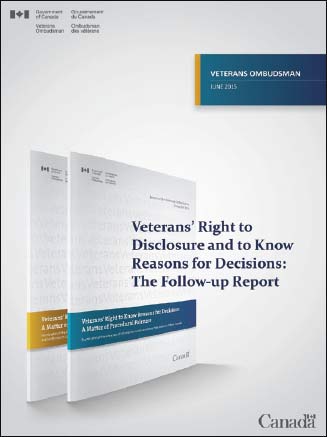
DECEMBER 2015 – The OVO published Veterans' Right to Disclosure and to Know Reasons for Decisions: The Follow-Up Report, the 5th report of the Procedural Fairness series.
FEBRUARY 2016 – The VO appeared in front of VEAC to discuss his idea for a new approach focused on outcomes for Veterans, not program activities; the Minister of Veterans Affairs tabled the OVO’s 2014-2015 Annual Report.
MARCH 2016 – The VO appeared in front of ACVA to discuss the ongoing study of service delivery at VAC; the OVO published, in conjunction with the DND/CF Ombudsman’s Office, three educational pieces on transition of medically-released members; the VO travelled with OVO advisors to Washington to seek out best practices in the treatment of Veterans and their families; the Government released Budget 2016, which contained several items designed to address shortcomings pertaining to benefits and services provided to Veterans and their families; the government’s Budget 2016 reflected many of the recommendations previously made by the Ombudsman in his reports; the VO and staff representatives conducted Outreach, including a public Town Hall and a stakeholder consultation meeting, in Kingston, ON. Military and family support facilities, as well as the VAC local office were visited; the OVO published Support to Military Families in Transition: A Review, a document that compiles support provided to military families and provides an update on recommendations made in relation to families.
Helping Veterans
Continued Treatment during Incarceration
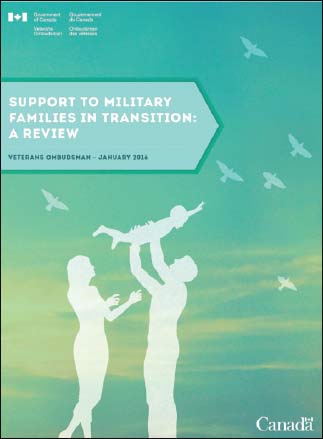
VAC was advised that a Veteran, who is pensioned for PTSD, was incarcerated. He was on the Rehabilitation Program at the time. VAC immediately cancelled his rehabilitation plan thinking he would be unable to participate given that he needed to undergo mental health treatment.
The Veteran repeatedly requested assistance from VAC while incarcerated but was denied. After we intervened, he was put back into the program – while incarcerated – as he was able to find a psychologist willing to provide treatment in a prison.
We also requested a review of the initial cancellation decision made by VAC, based upon the fact that no effort had been made to determine if the Veteran would be able to fully participate in his rehabilitation plan. VAC recognized there was no legislative authority to cancel his rehabilitation plan, and rescinded the cancellation decision.
Veterans who hold either a pension or disability award are entitled to receive treatment for the condition(s) for which the pension or award is granted. A new formal agreement between Correctional Service Canada and VAC is being put into place to ensure incarcerated Veterans continue to get the treatment they need.
Critical Dental Work Covered Despite High Cost
The OVO successfully intervened in a case where a Veteran was in dire need of a full set of dental implants. Implants, rather than dentures, were necessary due to xerostomia, a condition of chronic reduction in salivary flow. The Veteran had been denied the recommended dental work by VAC and his health was being adversely affected by excessive weight loss, as he was unable to ingest food. The OVO presented a valid argument to VAC to support the fact that the Veteran had a pensioned-related need for the dental work. As a result, VAC agreed to cover the cost of the treatment.
“We need to design benefits and administrative processes to achieve outcomes. Without a clear understanding of Veterans’ outcomes, tinkering with existing benefits is a recipe for evolving complexity and disappointment.”
Pension Act Clients Ineligible for Family Caregiver Respite Benefit Automatically Considered for Attendance Allowance
Following the creation of the Family Caregiver Respite Benefit (FCRB), a benefit under the NVC, some disabled Veterans in need of care applied but were deemed ineligible. They were turned down because they were in receipt of a Disability Benefit covered by the Pension Act. VAC indicated in a response letter that they may be entitled to the Attendance Allowance (AA) but that a new application was required in order to be considered for the benefit. Several of the dissatisfied clients contacted the OVO to complain about having to re-apply to be considered for the AA if deemed eligible. OVO raised the issue with VAC and they agreed to change its process and automatically consider those applicants for the Attendance Allowance leading to a closer Veteran-centric service delivery approach.
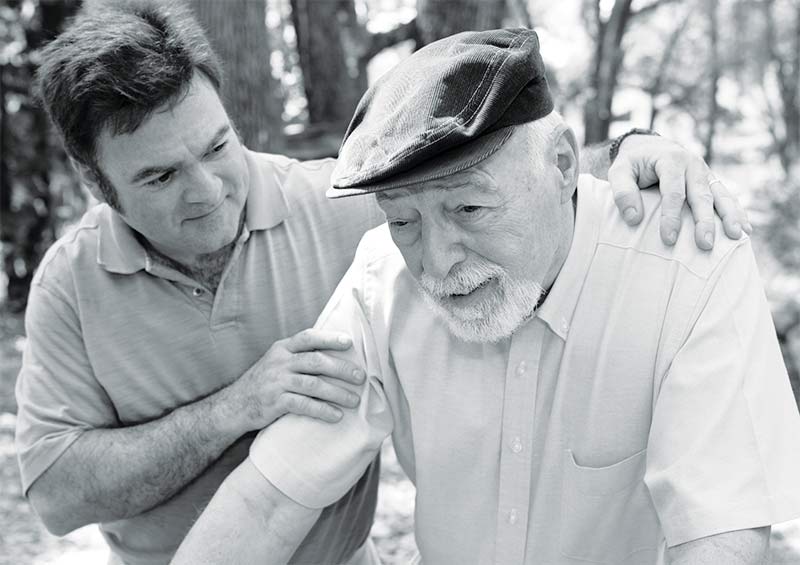
The Year at a Glance
How We Helped
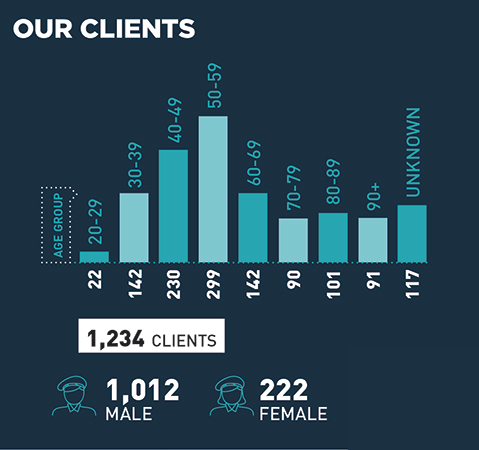
How We Helped
Our Clients
Age Group
- 20-29: 22
- 30-39:142
- 40-49: 230
- 50-59: 299
- 60-69: 142
- 70-79: 90
- 80-89: 101
- 90+: 91
- Unknown: 117
1,234 Clients
- 1,012 Male
- 222 Female
How They Reached Us

How They Reached Us
- Phone: 4,760
- Info Mail: 1,312
- Online Complaint: 195
- Fax: 141
- Letter: 108
- In Person: 55
- Total: 6,571
Their Issues Related to*
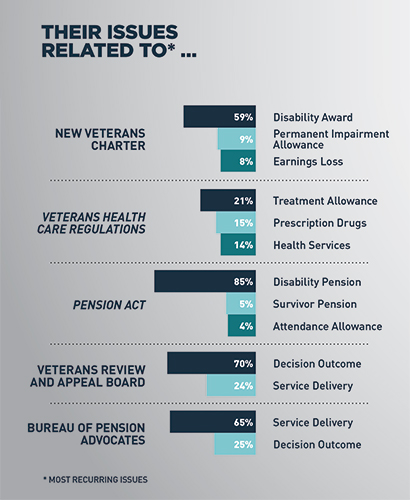
Their Issues Related to*
New Veterans Charter
Disability Award : 59%
Permanent Impairment Allowance : 9%
Earnings Loss : 8%
Veterans Health Care Regulations
Treatment Allowance : 21%
Prescription Drugs : 15%
Health Services : 14%
Pension Act
Disability Pension : 85%
Survivor Pension : 5%
Attendance Allowance : 4%
Veterans Review and Appeal Board
Decision Outcome : 70%
Service Delivery : 24%
Bureau of Pension Advocates
Service Delivery : 65%
Decision Outcome : 25%
* Most Recurring issues
Services Delivered
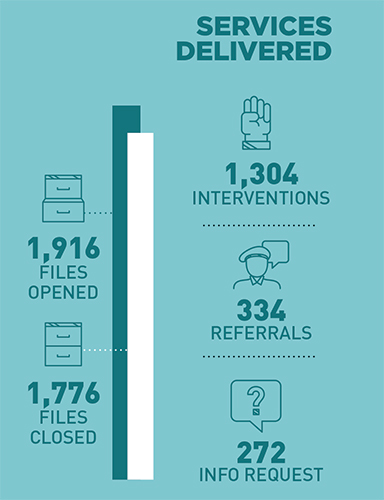
Services Delivered
- Files Opened: 1,916
- Files Closed: 1,776
- Interventions: 1,304
- Referrals: 334
- Info Request: 272
How We Educate and Inform
News Media*
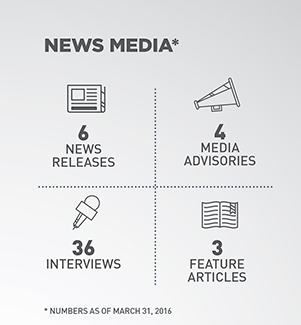
News Media*
- News Releases: 6
- Interviews:36
- Media Advisories: 4
- Feature Articles: 3
*Numbers as of March 31, 2016
Social Media*
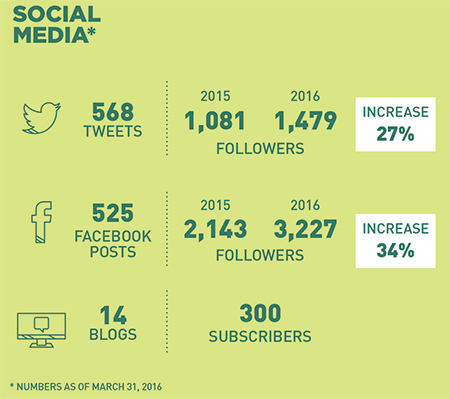
Social Media*
- 568 Tweets
- 2015 - 1,081 Followers
- 2016 - 1,479 Followers
- Increase of 27%
Facebook:
- 525 Posts
- 2015 - 2,143 Followers
- 2016 - 3,227 Followers
- Increase of 34%
Outreach
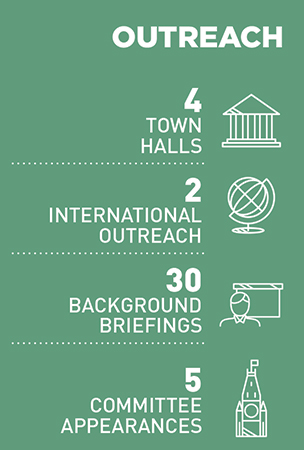
Outreach
- 4 Town Halls
- 2 International Outreach
- 30 Background Briefings
- 5 Committee Appearances
Published Reviews and Reports
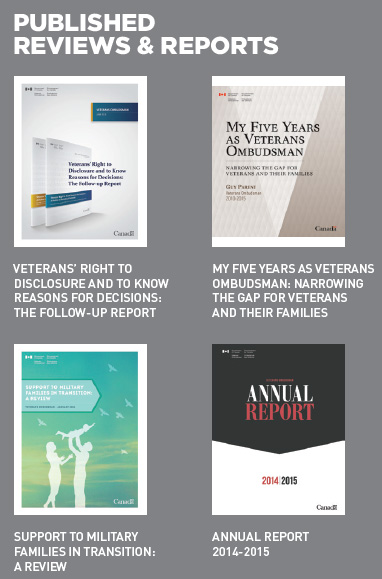
What Lies Ahead
I cannot stress enough the importance of keeping a laser-like focus on Veterans’ outcomes. We need to continue to look at issues around the sufficiency of benefits and the complexity involved in accessing them. We need to look at the end result we want to achieve and figure out the steps needed to obtain optimal results for Veterans and their families.
As I said before, this is an ambitious agenda, and I intend to work with my team to use the evidence and data we collect to influence change to benefit those in the Veterans’ community that need it most.
We will start by building upon the analysis that has been carried out and the recommendations that have already been made to fill the gaps identified in financial benefits provided to Veterans and their families under the NVC. As well as continuing to look at financial benefits in 2016-2017, we will be looking at how Veterans and their loved ones are compensated for the pain and suffering endured as a result of a service-related illness or injury. A report designed to shed light on what is or could be considered fair compensation for pain and suffering is currently in development.
We will also be examining existing VAC programs and benefits to determine if Veterans’ needs are being met. An actuarial analysis similar to what was produced in 2013 will be developed and used to inform decision-makers of the facts. I am convinced that an evidence-based approach is needed to ensure that the next round of changes truly make a difference in the lives of our Veterans.
In addition to influencing the dialogue on benefits, we will continue to push for Veteran-centric services and timely decisions for Veterans and their families. Veterans’ benefits need to be simplified and access needs to be seamless and easy to navigate.
We will continue to work with the Office of the DND/CF Ombudsman to share the results of our work on transition, to help clarify and improve the transition process for those leaving the military. Through engagement directly with Veterans who have successfully transitioned, we hope to determine which factors contribute the most to a successful transition. As a result of this work, we hope to provide solutions that will help mitigate this often stressful period and increase the quality of life of those undergoing this major lifestyle change.
And we can’t stop there because relief in other areas is also needed. For example, we are planning to continue to consult with families to determine what supports would best help them and to make recommendations that would best meet their needs. We will also be looking at the continuum of care for our aging Veterans to ensure that the health and well-being of all Veterans are being taken care of as they age.
None of this can be done in isolation. We will need the input of our staff, our partners, our advisors, our stakeholders and Canadians. We are therefore launching Twitter Chats and Online Town Halls in the future, starting with a Twitter Chat to help collect feedback and suggestions from transitioning military families. I look forward to the dialogue from these initiatives!
So stay tuned for more e-consultation of this nature on either our Facebook or Twitter sites as well as Outreach and engagement with our many stakeholders. After all, to adequately represent the Veterans’ community, I need to keep my finger on the pulse of issues affecting Veterans and their families, and that is precisely what I intend to do, through dialogue and collaboration.
Guy Parent
Veterans Ombudsman
“Veterans need hope. To have hope, you need forward movement. To have forward movement, you need better options ahead of you than behind you.”
Financial Statements
As per the 2015-16 Report on Plans and Priorities, the Veterans Ombudsman planned spending was $5.8 million for fiscal year 2015-2016. The actual authorities at the end of fiscal year 2015-16 were $5.2 million.
PLANNED SPENDING AND TREASURY BOARD AUTHORITIES 2015-2016
| Organization | Salary | Operating | 2015-16 Planned | 2015-16 Authorities |
|---|---|---|---|---|
| Office of the Veterans Ombudsman | $2,797,700 | $978,100 | $3,775,800 | $3,775,800 |
| Veterans Affairs Canada (provision of services to the Office)* | $729,526 | $698,772 | $1,428,298 | $922,198 |
| Employee Benefit Plan | $575,774 | $525,947 | ||
| Net Adjustments (incl. Collective Bargaining) | $6,141 | |||
| Total | $5,779,872 | $5,230,086 |
* 2015-16 Authorities reflect a transfer of $500,000 from the Veterans Ombudsman Program to the Internal Services Program.
VETERANS OMBUDSMAN PROGRAM AND OPERATIONAL EXPENDITURES 2015-2016
| Program or Operational Requirements | Expenditures |
|---|---|
| Salaries and Wages | $2,701,840 |
| Total Salaries and Wages | $2,701,840 |
| Transportation and Communications | $179,138 |
| Information | $5,984 |
| Professional and Special Services | $343,533 |
| Rentals | $9,696 |
| Purchased Repair and Maintenance | $17,650 |
| Utilities, Materials and Supplies | $28,368 |
| Acquisition of Machinery and Equipment | $42,735 |
| Other | $77 |
| Total Operating Expenditures | $627,181 |
| Total - OVO | $3,329,021 |
2015-2016 VETERANS AFFAIRS CANADA, PROGRAM AND OPERATIONAL EXPENDITURES FOR THE PROVISION OF SERVICES TO THE OVO (EXCLUDING INTERNAL SERVICES)
| Program or Operational Requirements | Expenditures |
|---|---|
| Salaries and Wages | $578,586 |
| Operating Expenditures | $116,900 |
| Total | $695,486 |
2015-2016 SUMMARY OF EXPENDITURES
| Organization | Expenditures |
|---|---|
| Office of the Veterans Ombudsman | $3,329,021 |
| Veterans Affairs Canada (provision of services) | $695,486 |
| Employee Benefit Plan | $525,947 |
| Other (Paylist Allocation, WFA, etc.) | $49,987 |
| Total expenditures | $4,600,441 |
